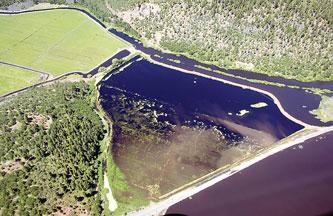http://pioneer.olivesoftware.com/Daily/Skins/heraldandnews/navigator.asp?skin=heraldandnews
Marshland farming doubtful
Farmer lost crops and farm equipment
By LEE JUILLERAT H&N Regional
Editor
Future agricultural use of 2,200 acres marshlands near the Running Y Ranch Resort that was flooded when dikes breached last summer appears doubtful.
Running Y spokesman Jon Barkee said it appears unlikely that acreage farmed the past century for potatoes, onions, grain and other crops will remain in production.
“Farming doesn’t seem to be a viable option,” Barkee said.
hole was completed flooded and the third and fifth holes were partially flooded. If the main dikes are removed, Barkee said dikes will be needed to protect the golf course.
“Initially people liked the water inflow,” he said of the reaction by Running Y residents after the breach, “but as the water receded and it began to smell it became a lot less appealing.”
Permanently breaching the dike system could increase Upper Klamath’s water storage, but Barkee said the impact would be minimal because the affected area is shallow and subject to evaporation.
“It’s all making it tough for farming. As a business proposition, it's probably not going to be viable. There are several things out there pointing against farming those lands.”
Ron McGill, who was farming the reclaimed Running Y lands, said he lost a million dollars worth of crops and 14 of his 26 pieces of farm equipment valued at $242,000.
“I don’t know what to expect,” McGill said of future farming in the reclaimed marsh, noting he has had little contact with Running Y officials.
“My losses are great,” he said. “We had all of that planted,” mostly in white wheat and some barley. The wheat is sent to Portland and sent to domestic and foreign markets, especially the Middle East, for crackers, pita bread and angel food cake.
He said crews were able to drive out some tractors before the area flooded while other pieces of farm equipment were floated out. More than half the equipment remains underwater — “I don't think they’ll be any salvage value left,” he said.
McGill has rented the property since 1976, rotating crops to prevent soil damage. He noted the marsh operation represented about 25 percent of his yearly farming, “So you can see it was a sizable part of our operation, and we had all the investment in it.”
Future agricultural use of 2,200 acres marshlands near the Running Y Ranch Resort that was flooded when dikes breached last summer appears doubtful.
Running Y spokesman Jon Barkee said it appears unlikely that acreage farmed the past century for potatoes, onions, grain and other crops will remain in production.
“Farming doesn’t seem to be a viable option,” Barkee said.
hole was completed flooded and the third and fifth holes were partially flooded. If the main dikes are removed, Barkee said dikes will be needed to protect the golf course.
“Initially people liked the water inflow,” he said of the reaction by Running Y residents after the breach, “but as the water receded and it began to smell it became a lot less appealing.”
Permanently breaching the dike system could increase Upper Klamath’s water storage, but Barkee said the impact would be minimal because the affected area is shallow and subject to evaporation.
“It’s all making it tough for farming. As a business proposition, it's probably not going to be viable. There are several things out there pointing against farming those lands.”
Ron McGill, who was farming the reclaimed Running Y lands, said he lost a million dollars worth of crops and 14 of his 26 pieces of farm equipment valued at $242,000.
“I don’t know what to expect,” McGill said of future farming in the reclaimed marsh, noting he has had little contact with Running Y officials.
“My losses are great,” he said. “We had all of that planted,” mostly in white wheat and some barley. The wheat is sent to Portland and sent to domestic and foreign markets, especially the Middle East, for crackers, pita bread and angel food cake.
He said crews were able to drive out some tractors before the area flooded while other pieces of farm equipment were floated out. More than half the equipment remains underwater — “I don't think they’ll be any salvage value left,” he said.
McGill has rented the property since 1976, rotating crops to prevent soil damage. He noted the marsh operation represented about 25 percent of his yearly farming, “So you can see it was a sizable part of our operation, and we had all the investment in it.”

